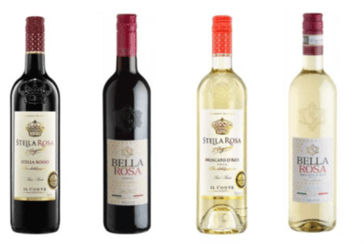In the case, San Antonio Winery, Inc. and Merritt Estate Winery, Inc. v. Enovation Brands, Inc., Civil Action No. 20-20515-Civ-Scola (S.D. Fla. Feb 24, 2020), the U.S. District Court for the Southern District of Florida granted Plaintiffs expedited motion for a temporary restraining order enjoining Enovation Brands from importing, selling, shipping, distributing or offering to sell its “Bella Rosa” wine.
Plaintiff San Antonio Winery imports and distributes the Stella Rosa family of wines. San Antonio has multiple federal trademark registrations protecting the Stella Rosa brand including incontestable U.S. Trademark Registration No. 4,000,417 for the word mark “STELLA ROSA” and incontestable U.S. Trademark Registration No. 3,663,013 for the mark “STELLA ROSA” and design for use in connection with wine. Since 2004, San Antonio has used the Stella Rosa mark in combination with what they describe as “distinctive, unique packaging to identify its wine.”
Defendant Enovation plans to distribute wine under the name “Bella Rosa” that San Antonio Winery believes infringes the trade dress of their “Stella Rosa” wines.
Below are depictions of the bottles, side by side with their alleged infringers.

Plaintiff pointed out what they believe are notable similarities in the trade dress: the word “ROSA” printed in red; the words “STELLA” and “BELLA” printed in black; red or maroon screw caps; gold accents on the screw caps; designs or emblems arranged on the glass directly above the labels; designs or emblems arranged on the labels that mirror the designs or emblems in the glass, directly above the marks; off-white label backgrounds; and the varietal names printed below the marks.
In response, Enovation claimed that Stella Rosa’s trade dress elements, in isolation, or even in some combination of a subset of them, are shared by dozens or hundreds of other wines and should be considered generic. The court found Enovation’s argument unpersuasive. In its order granting San Antonio Winery’s expedited motion for temporary restraining order, the court stated that “the unique combination, inclusion, and arrangement of these elements that renders the Stella Rosa dress distinctive.” Ultimately, the court found that “[w]ithout more, particularly in light of San Antonio’s ‘417 and ‘013 federal trademark registrations, Enovation has not overcome the showing that San Antonio’s trade dress is inherently distinctive.”
Given that the issue of distinctiveness (i.e., secondary meaning) relies on relevant consumers’ mental associations, it is interesting that Enovation does not appear to have conducted a secondary meaning survey to determine whether relevant consumers associate the claimed trade dress with a single source. Consumer surveys have been noted by courts to be the most persuasive type of evidence for proving or disproving a claim of secondary meaning.
In determining whether a likelihood of confusion exists, the court evaluated the claimed trade dress on seven factors. In its analysis, the court found a substantial likelihood that San Antonio Winery would succeed in demonstrating that Enovation’s label and packaging of its Bella Rosa wines is confusingly similar to the Stella Rosa trade dress. Specifically, the court found that six of the seven factors weighed in favor, to varying degrees, of a likelihood of confusion. As it relates to the seventh factor of actual consumer confusion, however, the court found that, “[e]ven though direct evidence of actual confusion is lacking, the Court’s assessment of the other six factors leads it to find the Plaintiff has shown a likelihood of confusion between the two companies’ products.”
Again, it is interesting that in a matter related to consumer confusion, neither party appears to have conducted a likelihood of confusion survey among relevant consumers. In the absence of actual consumer confusion, a likelihood of confusion survey could have been a persuasive piece of evidence for the court to consider. One can only wonder whether a survey put forth by Enovation showing no likelihood of confusion (or no secondary meaning) would have tipped the scales in the other direction.
Applied Marketing Science (AMS) has extensive experience conducting surveys to measure secondary meaning and likelihood of confusion in trademark and trade dress infringement matters. Our surveys have been submitted and accepted as evidence in litigation matters involving a broad range of products and services. To learn more about AMS trademark survey experts and our Litigation Support services, please contact Jason Och at joch@ams-inc.com.

